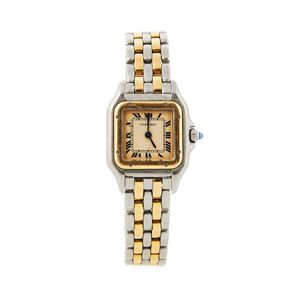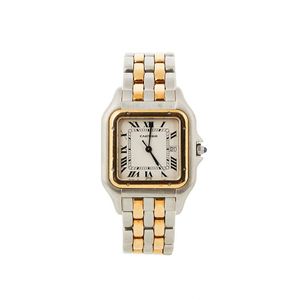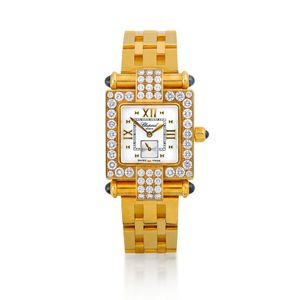Chopard Diamond and Sapphire Bracelet Watch
You must be a subscriber, and be logged in to view price and dealer details.
Subscribe Now to view actual auction price for this item
When you subscribe, you have the option of setting the currency in which to display prices to $Au, $US, $NZ or Stg.
- Movement - The technical name for the workings of a clock or watch, and does not include the dial or case.
- Engine Turned - Engine turning is a decorative technique used on metal surfaces to create intricate curving or geometric pattern. The process involves cutting a series of lines into the surface of the metal using a rose engine or decoration lathe which rotates the metal as it cuts, allowing the operator to create a repeating pattern that covers the entire surface. The resulting surface has a shimmering, reflective quality that is often described as "engine turned." Where an engine turned item has been enamelled, the term used to describe the decoration is usually guilloche.
Engine turning was originally developed to decorate metal objects such as firearms, scientific instruments, and other metal objects that required precise and elegant design. - Circa - A Latin term meaning 'about', often used in the antique trade to give an approximate date for the piece, usually considered to be five years on either side of the circa year. Thus, circa 1900 means the piece was made about 1900, probably between 1895 and 1905. The expression is sometimes abbreviated to c.1900.
- Bezel - On a clock or watch, the bezel is the metal frame into which the watch or clock glass is fitted. In clocks, the bezel may include a hinge and a flange, in effect a door to the face of the clock. In jewellery the bezel is a band of metal with a projecting lip that holds the gemstone in its setting.
This item has been included into following indexes:
Visually similar items

A ladies Cartier Panthere wrist watch, white dial, black Roman numerals, blue hands, stainless steel and 18ct yellow gold case and bracelet band, quartz movement, oriiginal cartier box

Cartier, two tone stainless steel and gold Panthere de Cartier ladies' wristwatch, Ref. 166921, c. 1990, quartz movement, 18ct yellow gold and stainless steel case with cabochon set crown, off-white matte dial with Roman numerals and sword-shaped hands in

Cartier, two tone stainless steel and gold 'Panthere De Cartier' Ladies' wristwatch, Ref. 166921, c. 1990, quartz movement, 18ct yellow gold and stainless steel case with cabochon set Crown, off-white matte dial with Roman numerals and sword shaped hands i

Cartier, two tone stainless steel and gold Panthere de Cartier wristwatch, Ref. 183957, c. 1990, quartz movement, 18ct yellow gold and stainless steel case with cabochon set crown, off-white matte dial with Roman numerals and sword-shaped hands in blued st
